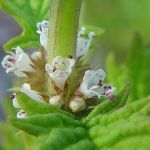| Common Name: |
Water Bugle |
| Other Names: |
Bugleweed, Gypsywort, Sweet Bugle, Virginia Bugleweed, Virginia Water Horehound |
| Botanical Name: |
Lycopus virginicus |
| Genus: |
Lycopus |
| Family: |
Lamiaceae |
| Cultivation: |
Moist to wet soil in sun or partial shade. Invasive. |
| Propagation: |
By seed sown in autumn or spring; by division in autumn or spring. |
| Harvest: |
Plants are cut as flowering begins and dried for use in infusions, liquid extracts and tinctures. |
| Native Location: |
Native to SE USA. |
| Height: |
20-80cm (8-32in) |
| Width: |
50-60cm (20-24in) |
| Warning: |
Not given to pregnant women or patients with hypothyroidism. For use by qualified practitioners only. |
| Hardiness: |
Z5-9 |
| Parts Used: |
Leaf, Flower, Stem, Root, Whole plant |
| Properties: |
A bitter, faintly aromatic herbs that controls bleeding, suppresses coughs, and lowers blood sugar levels. It slows and strengthens heart contractions and inhibits thyroid-inducing hormones. |
| Medicinal Uses: |
Internally for hyperthyroidism, nervous tachycardia, coughs (especially in patients with heart disease), tuberculosis, and excessive menstruation.
To treat mild thyroid hyperfunction, liver and kidney disease, tension, PMS, and pain in the breast (mastodynia). Germany's Commission E has approved the use of bugleweed to treat premenstrual syndrome, insomnia and nervousness. |
| Typical Dose: |
A typical dose of bugleweed may range from 1 to 3gm of dried herb taken three times a day. |
| Possible Side Effects: |
No side effects are known when bugleweed is taken in designated dosages. |
| Drug Interactions: |
| Taking bugleweed with these drugs may increase the risk of hypertension (high blood pressure): |
| Ephedrine, (Pretz-D) |
Ergotamine, (Cafergor, Cafergot) |
| Rizatriptan Benzoate, (Maxalt) |
Zolmitriptan, (Zomig) |
| Taking bugleweed with these drugs may increase the risk of hypoglycemia (low blood sugar): |
| Acarbose, (Prandase, Precose) |
Acetohexamide, (Acetohexamide) |
Chlorpropamide, (Diabinese, Novo-Propamide) |
Glicazide, (Diamicron, Novo-Glicazide) |
| Glimepiride, (Amaryl) |
Glipizide, (Glucotrol) |
Glipizide and Metformin, (Metaglip) |
Gliquidone, (Beglynor, Glurenorm) |
| Glyburide, (DiaBeta, Micronase) |
Glyburide and Metformin, (Glucovance) |
Insulin, (Humulin, Novolin R) |
Metformin, (Glucophage, Riomet) |
| Miglitol, (Glyset) |
Nateglinide, (Starlix) |
Pioglitazone, (Actos) |
Repaglinide, (GlucoNorm, Prandin) |
| Rosiglitazone, (Avandia) |
Rosiglitazone and Metformin, (Avandamet) |
Tolazamide, (Tolinase) |
Tolbutamide, (Apo-Tolbutamide, Tol-Tab) |
| Taking bugleweed with these drugs may interfere with diagnostic procedures related to thyroid deficiency: |
| Levothyroxine, (Levothroid, Synthroid) |
Litothyronine, (Cytomel, Triostat) |
| Liotrix, (Thyrolar) |
Thyroid, (Nature-Throid NT, Westhroid) |
|
| Lab Test Alterations: |
- May interfere with diagnostic procedures using radioactive isotopes, such as positron emission tomography (PET scans).
- May improve thyroid function in those with mild hyperthyroidism.
|
| Disease Effects: |
- May trigger hypoglycemia (low blood sugar) in people with diabetes.
- May interfere with thyroid treatments.
|
| Supplement Interactions: |
May alter the effects of herbs and supplements that have thyroid activity, such as Balm Leaf and Wild Thyme. |
| Bibliography: |
Encyclopedia of Herbs by Deni Brown. Copyright © 1995, 2001 Dorling Kindersley Limited. pg 268
The Essential Herb-Drug-Vitamin Interaction Guide by George T. Grossberg,MD and Barry Fox,PhD Copyright ©2007 By Barry Fox,PhD. Pp 102-103
|

